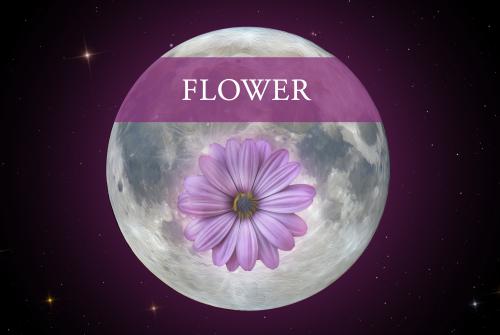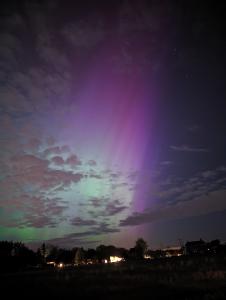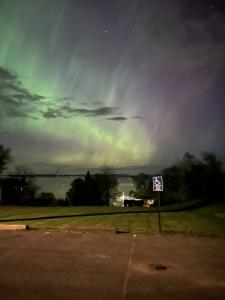Celebration of Space - May 17, 2024
On Thursday, May 23, 2024 at 9:56 am ET, the Full Flower Moon of May will occur. On this day, the Moon will rise with the setting Sun, and set with the rising Sun, keeping the Moon above the horizon for the entire nighttime period. Now that we are in the second half of spring, the full Moon is rising further south along the horizon, and crossing the sky much lower as the ecliptic (path the Sun takes across the sky) drops lower with each passing night until we reach the Summer Solstice. This will cause the Moon to appear more yellow due to the scattering of blue light in Earth’s atmosphere.
Other names the May Moon go by, according to the Old Farmer’s Almanac, are the Budding Moon, Planting Moon, Frog Moon, and Moon of the Shedding Ponies. Regardless of what you call the May Moon, be sure to step outside around sunset on the night of the 22nd, and look to the SE horizon to catch a view of the Full Flower Moon rising, and welcome warmer temps.
Last Friday, May 10, 2024, we wrote about the high probability of lower latitude Aurora Borealis due to a very precise timed set of coronal mass ejections that were heading towards Earth. Even though we expected a rather impressive view for our region, we certainly did not expect what had actually happened.
During the mid-afternoon time frame, after we had released our weekly Celebration of Space newsletter, the Planetary K-Index (Kp) jumped to 9, the highest it can go, and the highest I have ever seen. In Rhode Island we need a Kp7 to catch a faint view of the Aurora, at Kp9 I was unsure what to expect, but something would certainly happen. When the first jump to Kp9 occurred it was still very much daytime. Not all geomagnetic storms last that long, and on our team Discord, we were speculating on how the storm would continue to play out. Add in that we were completely overcast at this time, and expecting overcast conditions overnight, the team had already started to either plan a miss or head out to locations with potentially better weather.
Once sunset, twilight, and night came around, the sky remained overcast, and our thoughts on seeing the Aurora began to fade. It wasn’t until around 10:00 pm when one of our Astronomy Team members, Sean, who was camping with his family in NH, posted a quick pic from his phone to our Discord with the text “Guys…..”. In the pic was a view of two green spikes over the horizon through a small break in the clouds. That was all we needed to grab our gear and run outside. The search for a clearing in the clouds began.
Shortly after, pics started pouring into the team Discord from our team members all over Southern New England. I drove around Cranston and Scituate Rhode Island looking for clearings, and every time we found one, the Aurora was clearly visible to the naked eye. Astronomy Team member Greg had already traveled to the northwest region of Connecticut with the hope of catching a view as clouds departed. He had the best pics of the night. Team member Marielle was in upstate New York with her family and jumped outside to catch a pic of the entire sky lit up. Team member Autumn had traveled with some friends to the Charlestown, Rhode Island area, and found a few spots with a clearer view. By the next morning we had quite a collection of pics from the Aurora event.
As we talked about the Aurora over breakfast on the team Discord, it became apparent that the Northern Lights were visible as far south as Mexico, with pics coming out of the Florida Keys of the Northern Lights. In my time I have seen the Northern Lights at the Arctic Circle, and this was the first time I had seen the Aurora Borealis so clearly outside of that region. It was certainly a night to remember.
Check out some of the pics that we captured that night in our Aurora Borealis photo gallery on our website. Even though that geomagnetic storm is well over, we are seeing a rather significant solar maximum approaching, and perhaps another night of stunning Aurora Borealis viewing is in store for the near future. If you have a cool experience or story of your own about that night which you would like to share, send it to us as a reply. We would love to hear it.
Evening passes of the International Space Station (ISS) continue over our region this weekend and coming week, with several good viewing opportunities. Here are a few notable passes for the next several days:
Sat, May 18 at 11:41 pm, starting in the NW. rising to 22º, and into orbital sunset
Sun, May 19 at 10:52 pm, starting in the NW, rising to 24º, and into orbital sunset
Tue, May 21 at 10:48 pm, starting in the NW rising to 41º, and into orbital sunset
Wed, May 22 at 9:58 pm, starting in the NW, rising to 29º, heading towards the ENE, and into orbital sunset
Wed, May 23 at 9:08 pm, starting in the NW, rising to 22º, heading towards the ENE
Wed, May 23 at 10:45 pm, starting in the WNW, rising to 48º, and into orbital sunset
Thu, May 24 at 9:55 pm, starting in the NW, rising to 60º, heading towards the E, and into orbital sunset← awesome pass!
Many of these passes are getting a bit late for perhaps younger children to catch a view, and this is happening due to the later sunset times as we approach the Summer Solstice. Regardless, if you can step out for a view, it will be worth it.
- Author:
- Scott MacNeill
- Entry Date:
- May 17, 2024
- Published Under:
- Scott MacNeill's Columns





